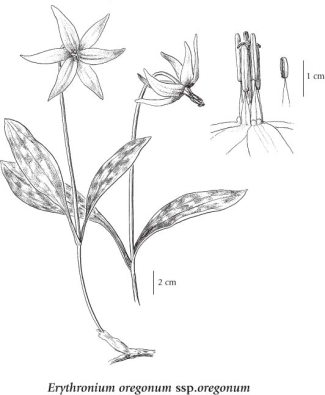Click on the image below to view an
expanded illustration for this species.

|
General:
Perennial herb from a narrowly egg-shaped, 3- to 5-cm long bulb and an elongate, segmented corm; flowering stems 15-35 cm tall, smooth.
Leaves:
Basal leaves 2, dull dark green mottled with brown and white or pale green, lanceolate to oblong-elliptic, 10-20 cm long, smooth, abruptly narrowed to short, broad, somewhat winged stalks, the margins entire but often somewhat wavy; stem leaves lacking.
Flowers:
Inflorescence of 1, sometimes 2 or 3, flowers atop a leafless, unbranched, smooth stem; flowers white with some yellow or orange at the base on the inner surface, nodding, of 6 similar, distinct tepals, the tepals broadly lanceolate, 3.5-5 cm long, curved back; stamens 6, anthers white or yellow; pistil 1, 3-chambered.
Fruits:
Capsules, broadly club-shaped, erect, 3.5-5 cm long; seeds several to many, brown, egg-shaped, angular.
Source: The Illustrated Flora of British Columbia
|
